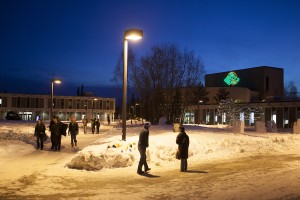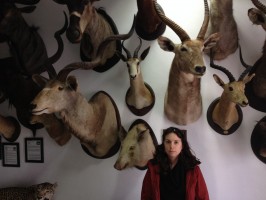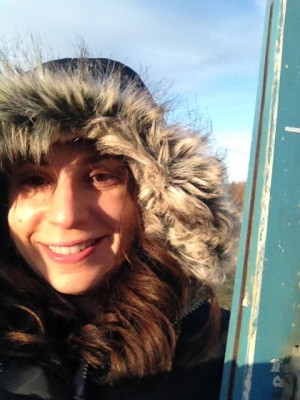What makes a cold city cool? Investigating urban design
by Jamie Gonzales |
Where you and I might see nothing more than an empty parking lot or a barren stretch of sidewalk, Bree Kessler sees a pop-up drive-in movie theater or space for a mobile library. With a background in environmental psychology, Kessler studies the way people interact with the urban landscape. How do changes in the built environment-sidewalks, stairs, parks-shape the way people interact with it and with each other? How can we activate some of the underused spaces on campus and in Anchorage?
For the last two years Kessler, a term assistant professor in UAA's Department of Health Sciences and a faculty fellow with the Center for Community Engagement & Learning, has been investigating winter cities everywhere from Rovaniemi, Finland, to Copenhagen, Denmark, to learn more about innovative urban designs and interventions that make these cold cities cool.
"Why are people congregating outside? What is happening there that we could do in Anchorage? There are small fixes that don't need to be major capital projects," said Kessler. The ideas go beyond the typical winter athletic activities like skiing and fat tire biking.
"Good seating, food and entertainment attract people," she said. In a cold city, just add a little heat. A couple weeks ago, she worked with collaborators at the Anchorage Museum to screen Blue Hawaii on the "lawn" in front of the museum. With minimal advertising, they had 80 people show up with blankets and snacks for a little Elvis-in-the-tropics fun. A few heat lamps helped take some of the chill out of the air.
"In a lot of other cities there are burn barrels and heat sources everywhere," she said, going on to describe the gas heat lamps built into awnings that kept restaurant patrons outside sipping coffee even in snowy weather. "Heat is a cheap, easy fix."
Kessler's objective in investigating northern cities is to collect data surrounding successful public spaces to see how we Anchorageites might best enjoy our own winter city. It turns out the literature is sparse.
"When I started my research I learned there's limited scholarship on the urban arctic," she said.
How to be a flâneur
When Kessler visits a new city, she approaches it a little like some of Alaska's storied Arctic explorers approached the wilderness, but with fewer supplies strapped to her back. Instead of backcountry adventures, she goes on urban expeditions and lets the city's design and flow guide her.
It's an exercise she gives to students in her classes, too.
"I use a method called being a flâneur," she said. "It's participant observation, essentially wandering around a city."
"Hey," you're thinking. "I've done that." And it's probably true. What started out as 19th century French term for "stroller" or "saunterer," flâneur came to mean more to scholars and artists, something more along the lines of a keen urban spectator.

UAA's Cuddy Quad got a facelift during Winterfest with CCEL's Winter Design Project. Philip Hall/University of Alaska Anchorage
Those of us who are apt to carry a notebook into the woods on a hike to journal about nature are a lot less likely to record our observations from a walk through downtown Anchorage, though.
In America in the 1970s, journalist William Whyte was turning his attention to the use of urban spaces and popularized methods for observing and objectively measuring city dynamics, something that hadn't been scientifically studied. He published The Social Life of Small Urban Spaces in 1980 detailing his findings.
Kessler is also applying Whyte's methods to the study of winter cities. For instance, to monitor use patterns in UAA's Cuddy Quad during Winterfest and the Winter Design Project that filled the space with art installations, music and nightly burn barrels, she mounted a rooftop camera to take time-lapse images of the activity. (See some of the time-lapse footage here on the CCEL website.)
What she's looking for when she studies the images are changes in the way students or visitors interacted with the quad. Did the intervention draw more people outside? Did they linger longer?
Projects for a vibrant community
"I really want cities to be involved in organizing what they want to see happen," said Kessler, who has a background in community organizing, in addition to her credentials in public health and environmental psychology.
Her idea for a pop-up drive-in theater at UAA isn't new, though it would be a first for the university. If she can secure the funding, somewhere in the neighborhood of $2,000, Kessler wants to screen a film next month in one of UAA's parking lots, which empty out after about 6 or 7 p.m. most evenings. National Public Health Week is April 7-13 and screening a film that sparks some public health discourse could be a great use of the space.

To get the flavor of a new city, it's important to check out the museums, like this hunting museum in Spain. Photo courtesy of Bree Kessler.
She's also working with partners to put on the second Urban in Alaska conference Friday, March 28, where faculty, students and community members will engage on social issues that impact the design of public space.
And those mobile libraries I mentioned? She's working with students and hopes to see those manifest beside three bus stops and along two well-traveled park paths this fall. The library shelves would be stocked with mini proposal books put together by community members outlining their best ideas for public spaces in Anchorage. The first proposal books will be piloted at the Urban in Alaska conference.
Poll any group of Anchorageites and you'll get a mixed response when you ask them about Town Square Park. Everything from "cool ice sculptures" to "that's a homeless hangout." Kessler has joined with a long list of community partners to find some simple design solutions that will enhance what people like about the park and help diminish its bad reputation. For Kessler, she sees it less as a crime problem and more as an underuse problem. The community partners are planning a dinner party in the park on Friday, April 25, and a charrette-a collaborative design process-the next day, Saturday, April 26, to develop new models for the park.
"A lot of these efforts are a little selfish," admits Kessler. "I want Anchorage to be a really cool place to live in."
In May, as part of her winter city research, she'll be visiting Iceland. Expect more new ideas when Kessler returns.
To learn how you can be involved in some of these projects, you can email Kessler at bckessler@uaa.alaska.edu.
Written by Jamie Gonzales, UAA Office of University Advancement.
 "What makes a cold city cool? Investigating urban design" is licensed under a Creative Commons Attribution-NonCommercial 4.0 International License.
"What makes a cold city cool? Investigating urban design" is licensed under a Creative Commons Attribution-NonCommercial 4.0 International License.















